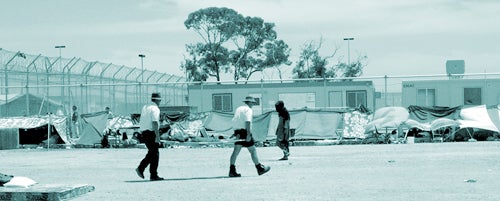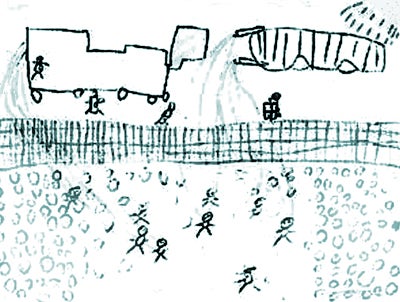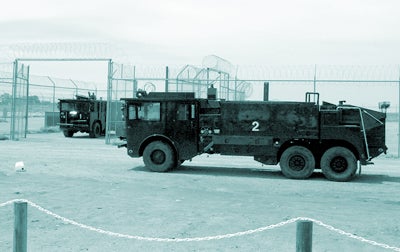A last resort? - Summary Guide: Safety in Detention Centres
A last resort?
National Inquiry into Children in Immigration Detention
| back to Summary Contents || A Last Resort? Homepage || Text Only Version |
 |
|
Under the Convention on the Rights of the Child, children have a right to live in a safe environment. Throughout the course of the Inquiry, a number of serious disturbances occurred in immigration detention centres, including riots, fires, hunger strikes, protests, self-harm and suicide attempts. In addition, the Inquiry heard that the measures taken to address disturbances in the detention centres - such as the use of tear gas and water cannons - left children feeling frightened and unsafe. During these incidents, children were exposed to a level of risk to their physical safety - and, as a consequence, to their mental health - that children in the community are unlikely to face. Disturbances and unrest
Between July and December 2001, the Department recorded 688 major incidents involving 1,149 detainees across all detention centres. Of these incidents, 321 were alleged, actual or attempted assaults (19 involved children), 174 involved self-harm (25 involved children) and about 30% involved 'contraband, damage to property, disturbances, escapes and protests'. Almost 75% of these incidents occurred in the Curtin, Port Hedland and Woomera centres, where the largest number of children had been detained for the longest periods of time. From January to June 2002, there were 760 major incidents involving 3,030 detainees across all detention centres. There were 116 alleged, attempted or actual assaults (16 involved children), 248 self-harm incidents (25 involved children) and 52% involved contraband, damage to property, disturbances, escapes and protests. Almost 80% of all incidents occurred in the Curtin, Port Hedland and Woomera centres. The following chronology of major disturbances in the Woomera, Curtin and Port Hedland detention centres gives some sense of the environment in which the majority of children in immigration detention were living. It doesn't provide a comprehensive description of each and every disturbance in the detention centres. It has been drawn together primarily from media reports. Major disturbances in immigration detention centres: Jul 1999 - Dec 2002
Disturbances in WoomeraThe Woomera detention centre, which opened in 1999, was the site of more disturbances than any other centre. In this relatively small and contained environment, children were inevitably exposed to the riots, protests and violence that occurred. As one detainee father at Woomera told the Inquiry: "They know everything - who cut themselves, who try to hang themselves." The Inquiry visited Woomera three times - in January 2002, June 2002 and September 2002. During the first visit - at a time when 281 children were detained there - there was a major hunger strike, involving a large number of detainees. During this period, more than 30 children joined the hunger strike and a number of children sewed their lips. Two unaccompanied children swallowed shampoo and disinfectant and one boy cut the word 'freedom' into his arm. Extensive riots occurred at Woomera during Easter 2002, which coincided with a major protest held outside the centre. During the riots:
Video evidence of the Easter riots shows that some children were actively participating in the riots and others were highly distressed by what was going on around them. Security proceduresMaintaining safety and security in detention facilities is a very challenging task. Some detainees have been violent during demonstrations, arming themselves with makeshift weapons and threatening staff. On some occasions, fences were pulled down and staff had to prevent detainees from escaping. It is clearly legitimate for staff to protect themselves at times when they are being threatened. However, evidence to the Inquiry suggests that sometimes the security measures used compromised the physical safety and mental health of children. When children are detained in a closed environment, the options available to shelter them from those events are limited. Thus the detention of children in immigration detention centres simultaneously increases the risk of harm to children and limits what can be done to address that harm. The use of tear gas and water cannons and the sight of detention staff dressed in 'riot gear' caused particular distress to children. These experiences featured in drawings that detainee children presented to the Inquiry.
The Department and ACM acknowledged that they had a special responsibility to protect children from harm whilst the children were held in immigration detention. However, evidence to the Inquiry suggests that procedures in place to address unrest in detention centres did not sufficiently take into account the need to provide children with special protection. Protecting children from harm during disturbances - who has responsibility?
ACM and the DepartmentACM, through its contract with the Department, has primary responsibility for maintaining security in the detention centres. However, ACM told the Inquiry that several factors made it difficult for them to fulfil that responsibility. For instance, the Inquiry was told that the infrastructure and, in particular, the 'design limitations' of the Woomera and Curtin centres made it difficult to protect children from violent incidents. Whilst families were sometimes given the option to move to safer areas before or during a riot or disturbance, there were other times when ACM staff would implement a 'lock down' procedure to try and contain violence within a particular compound. As a result, parents and children were sometimes trapped in the middle of a riot. A former ACM Operations Manager spoke of the problems he encountered during a 'lock down':
Even when families were able to move to a safer compound, children were not always protected from the psychological impact of the riots, either because the disturbances occurred in all the compounds or because children were frightened by what they could still see and hear going on nearby.
ParentsBoth ACM and the Department expressed the view that parents of detainee children had a responsibility to prevent their children from witnessing riots and other distressing events, particularly when they were given the opportunity to remain in their accommodation units or move to other compounds. The Inquiry accepts that parents have primary responsibility for their children in such circumstances. The Inquiry also acknowledges that some parents did participate in the demonstrations and, therefore, may not have removed their children to a safer place. However, the ability of parents to protect their children in such situations should be put into context. Within the detention environment, parents are forced to protect their children from situations of violence that they would only rarely encounter in the community. The frequency of major disturbances in detention centres through 2001 and 2002 also made it difficult to prevent exposure to violence. In addition, parents faced the same problems as ACM staff - that is, trying to find a safe place for their children in a relatively small, contained environment.
|
|
© Human Rights and Equal Opportunity Commission. Last updated 13 May 2004. Comments and feedback welcome. Email: webfeedback@humanrights.gov.au |




